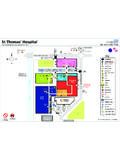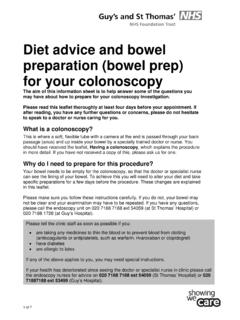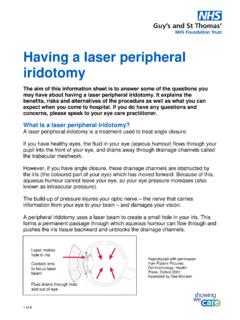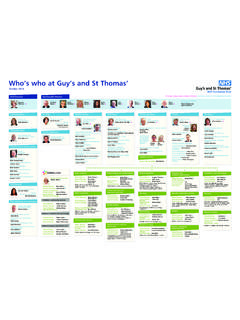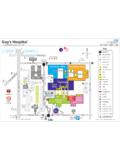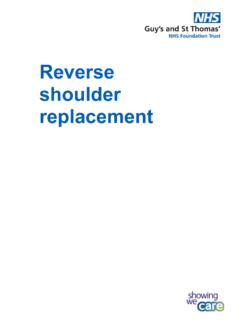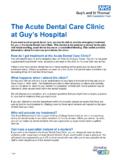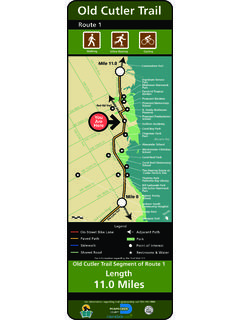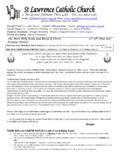Transcription of Returning to everyday activities after abdominal …
1 1 of 4 Returning to everyday activities after abdominal surgery Leaving hospital is an important step in your recovery after having abdominal surgery . Everyone is different and recovers at their own pace. This information sheet has been given to you to help answer some of the questions you might have about Returning to your everyday activities . If you have any questions or concerns, please speak to your physiotherapist, occupational therapist, nurse or doctor. Conserving your energy You might feel tired after surgery and will need to make the most of your energy. Try the following. Pacing spread tasks throughout the day and try not to cram everything into the morning.
2 Prioritising does it need to be done today? Planning choose the best time of day for you to do your activities . When can I return to my everyday activities ? Lifting and strenuous activity Your abdominal muscles help to protect your back during strenuous activities and lifting. These muscles might be weak after your operation and you will need to be particularly cautious about lifting and carrying objects for at least six weeks after your operation. We would advise that you do not pick up anything heavier than a full kettle of water during this time. Some tips: assess the object before lifting, such as its size and weight bend at the knees to pick up the object avoid twisting when bending, lifting or putting an object down carry the object in both hands hold the object close to you.
3 You should avoid pushing and pulling activities , such as vacuuming, scrubbing the bath, hanging up heavy washing, and mowing the lawn. 2 of 4 Work When you can return to work will depend on the type of work you do and your stage of recovery. A gradual return to work may be advised, such as starting off with light duties or reduced hours. Please speak to your physiotherapist, occupational therapist or doctor about when and how you should return to work. Driving The Drivers Medical Unit at the Driving and Vehicle Licensing Agency (DVLA) suggests listening to your surgeon s advice. You should only drive again when you are free of pain and able to perform an emergency stop comfortably.
4 You should check with your insurance company to make sure you are covered to start driving again. Posture and stretches Maintaining a good posture will help your wound heal correctly. Repeat the following positions slowly. It is normal to feel a slight pulling sensation. Try to do them three times a day, gradually building up to five repetitions of each. Stretch 1 While standing, gently push your hips forward and lean backwards. Stretch 2 Either place your hands behind your head or cross them on your chest and gently bend to the side to feel a stretch on the opposite side. Rotations Cross your arms over your chest and clasp the opposite shoulder.
5 Gently twist / rotate slowly to each side. You can stop these stretches when you feel you are back to the level you were before the operation. Image PhysioTools Image PhysioTools Image PhysioTools 3 of 4 Why do I need to exercise? There are many benefits to regular exercise including: lower blood cholesterol, blood pressure and heart rate improved muscle tone, flexibility, body shape, posture, balance and co-ordination weight control improved blood sugar levels improved well-being and self-confidence help with relaxation and stress management. Walking is one of the best exercises to do. You should walk at a steady pace, but still be able to talk comfortably.
6 The goal is to walk for 30 minutes, five days a week. Below are some markers to help you progress with your recovery at home. Weeks 1-2: It is important that you stage your recovery in the first few days at home, to make sure that you don t do too much. However, keeping active is still important. Go for a walk each day, starting with 5-10 minutes and increasing this day by day. If you usually use the stairs at home, you can continue to do this from the first day you return. Weeks 2-4: As you start to feel stronger, you can start doing daily activities such as dusting and making light meals. It is still important to keep active, so start walking further, but make sure that you pace yourself.
7 You may find that using goals help, such as increasing the length of time or distance that you are walking. Weeks 4-6: By now you should feel comfortable to be doing more around the home, such as ironing and cooking. You still should not lift any heavy items such as suitcases or heavy shopping. This is because your abdominal muscles are still weak. By week six you should be able to walk for 30 minutes comfortably. Weeks 6-12: By week 12 you should find that you are back to normal. If you have any questions with regards to more strenuous exercises please speak to your GP or surgeon. Your abdominal muscles The incision in your abdomen will weaken your abdominal muscles and it is important to get these muscles strong again.
8 These muscles help us to get out of bed, sit up, and lift something as light as a cup of tea. The deep abdominal muscles also play an important role in supporting the back. The following exercises will help to strengthen your stomach muscles. Knee rolling Lie on your back with your knees bent and feet on the floor. Slowly roll your knees together from side to side. Image PhysioTools 4 of 4 Pelvic tilts Lie on your back with your knees bent and feet on the floor. Place your hands in the small of your back. Gently press the small of your back onto the floor. Continue these exercises for at least three months.
9 Pharmacy Medicines Helpline If you have any questions or concerns about your medicines, please speak to the staff caring for you or call our helpline. t: 020 7188 8748, Monday to Friday, 9am to 5pm Your comments and concerns For advice, support or to raise a concern, contact our Patient Advice and Liaison Service (PALS). To make a complaint, contact the complaints department. t: 020 7188 8801 (PALS) e: t: 020 7188 3514 (complaints) e: Language and accessible support services If you need an interpreter or information about your care in a different language or format, please get in touch. t: 020 7188 8815 e: NHS 111 Offers medical help and advice from fully trained advisers supported by experienced nurses and paramedics.
10 Available over the phone 24 hours a day. t: 111 NHS website Online information and guidance on all aspects of health and healthcare, to help you take control of your health and wellbeing. w: Contact us If you have any questions or concerns regarding the information given in this leaflet, please contact the Physiotherapy department. t: 020 7188 5094, Monday to Friday, to 7pm. For more information leaflets on conditions, procedures, treatments and services offered at our hospitals, please visit w: Leaflet number: 0082/VER3 Date published: November 2018 Review date: November 2021 2018 Guy s and St Thomas NHS Foundation Trust A list of sources is available on request Our values: Put patients first | Take pride in what we do | Respect others | Strive to be the best | Act with integrity Was this leaflet useful?
